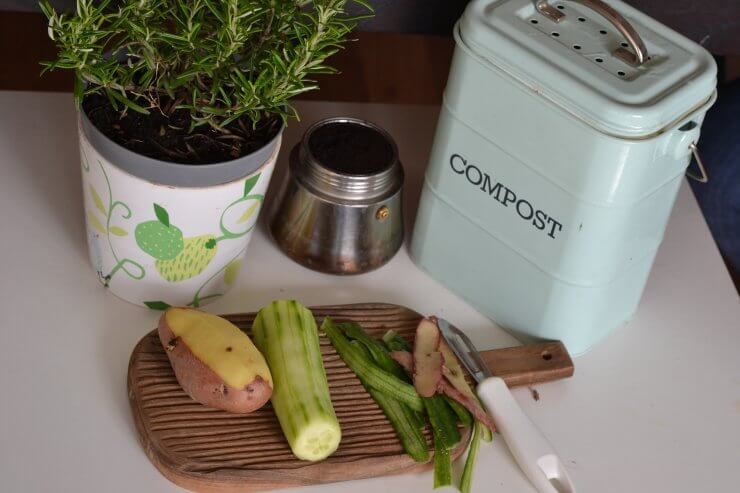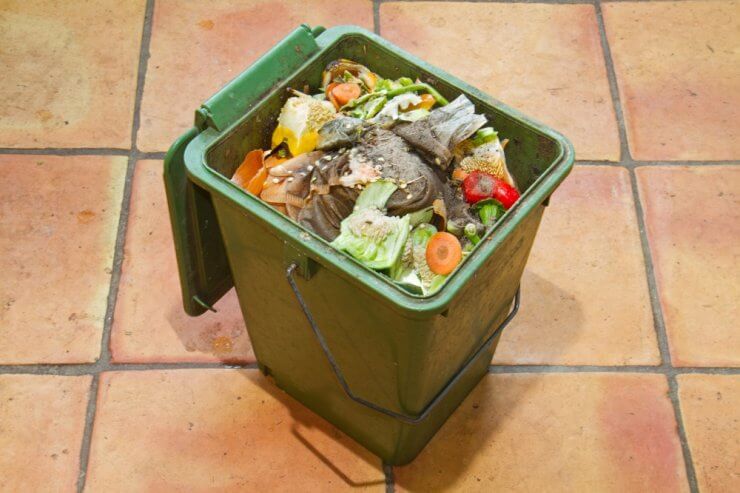
I don’t want to write about bugs in compost bins any more than you want to read about it, but it happens, so here we are. Don’t worry; I’m not going to get into the creepy-crawly details. For your sake and mine, we’ll keep it vague. I’m still emotionally scarred from that scene in The Lost Boys (If you know, you know).
That said, it’s not uncommon to, at least on occasion, end up with bugs in compost bins. However, that does not mean that you have to live in fear that your home is going to turn into an uninhabitable pit. To be clear, by the way, I’m referring to indoor compost bins, here. I’m pretty sure trying to keep insects and critters away from an outdoor compost bin or pile would be more challenging than trying to kayak upriver without a paddle.
Discover 7 top tips for growing, harvesting, and enjoying tomatoes from your home garden—when you access the FREE guide The Best Way to Grow Tomatoes, right now!

Dealing with bugs in compost bins (and not freaking out!)
It’s worth pointing out that some “bugs” and some compost bins are meant to go together. Worm composting, for example, is an efficient and popular way to compost. Of course, you and I both know that’s not what we’re talking about here.
The bugs in compost bins that we’re talking about are those unwelcome creatures that most of us don’t want in our homes. You may have a compost bin in your home that you use to collect food scraps to put in your backyard compost heap. You may have a small tumbler that you keep on your balcony. Or you may subscribe to a composting service and collect compost for about a week before it gets picked up. Whichever the case, you don’t want bugs.
Here are a few tips for managing that issue. I’m especially fond of the first one, which I think you’ll appreciate for several reasons.
1. Use a bucket with an airtight lid. One of my friends uses a five-gallon bucket to hold compost until he takes it to a community composting site. In several years of composting this way, only once has there been an issue with bugs because he didn’t put the lid on correctly. Oops! An airtight lid accomplishes several things: it prevents odors from escaping and keeps bugs (and motivated dogs) out of the compost.
2. Add more brown. Generally speaking, a 1:1 ratio of brown and green materials is ideal for compost. It’s also easy to get out of balance, especially if much of your indoor compost bin consists of food scraps. If you find that your compost bin is heavy on fruit pits, vegetable peels, and the like and it’s attracting bugs, add a layer of brown, such as shredded egg cartons or brown paper bags.
3. Empty your bin more often. This is one of the surest ways to keep your bin bug-free. Especially in the summer when your windows are open, and there’s more activity in nature, empty your bin.
4. Wash your bin. If you don’t have too many bugs and catch the issue early, you can empty your bin as soon as possible and wash it thoroughly with soap and water.
5. Freeze it. One way to manage bugs in compost bins is to eliminate the items that attract them. Empty and clean your compost bin, then, instead of reusing it right away, store all your compost in a bag in your freezer for about a week. That should be enough time for any lingering insects to find somewhere else to go for dinner.
If for some reason, none of these solutions are working and you’re still having issues, it might be time to look outside the compost bin. Fruit bowls, garbage disposals, and clogged drains can all attract way more bugs than you might believe.
Have you had problems with bugs in compost bins around your home? How did you handle it?
Discover 7 top tips for growing, harvesting, and enjoying tomatoes from your home garden—when you access the FREE guide The Best Way to Grow Tomatoes, right now!





Bugs in compost bins: I used to put my grub worms in a can, but I am a pacifist, pacifists do not have the ability to kill, so I’d take the bug across the street and place him in my neighbor’s yard to give him a chance to relocate. I was an affiliate of Hellman’s at Smith college Ken Hellman, Ken and Barbie.
We have tiny fruit flies/gnats in our kitchen compost container. The container is stainless steel with a tight fitting lid, with a charcoal filter. We have to leave it outside and quickly add kitchen scraps to it so the fruit flies don’t all fly out in our face. Any suggestions? We wash it thoroughly each time we empty it into the bin near the garden. Thank you.
I hate fruit flies and battle with them every summer. I’ve tried all sorts of traps and found that a diy paper cone trap works best at my house. Check out this article: https://www.apartmenttherapy.com/how-to-make-a-fruit-fly-trap-h-108577